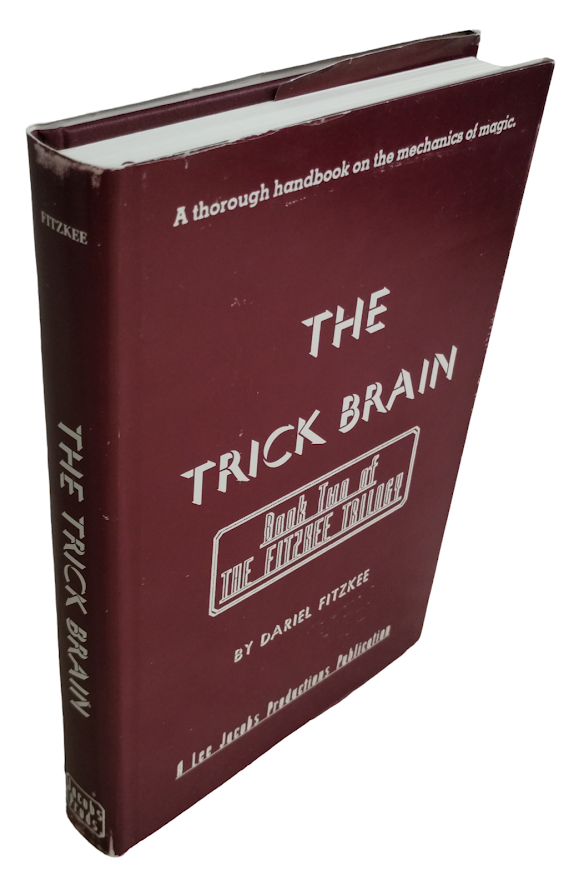The Trick Brain - Book Two - Dariel Fitzkee - Contento Estate
Availability: In stock
Collection: All Products, Antiques/Estate, Close-Up Magic, Effects, Instructional Books, Magic Books, Parlor Magic, Tag Books, What's Hot, What's New
This is book two from Fitzkee's trilogy and is unlike any other book ever written on magic. It was the first book (and to my knowledge the only book) to attack magic methods from a scientific standpoint. Fitzkee develops here a classification of effects, from appearances to vanishes, and then describes a system to invent or develop new trick plots. This is an invention system. I would say it is one way to invent new trick plots. But even if you are not of the scientific sort, the classification and discussion of magic effects and methods is a tremendous resource to expand your horizon and think in new ways about magic.
Paul Fleming wrote:
"The purpose of this book," says the author on page 225, "is to teach you to invent your own tricks. I'm trying to give you the information and equipment with which to accomplish this objective." And a little later (page 237), he makes this statement: "The Trick Brain is a mechanical method of stimulating the imagination in the invention of new trick plots or combinations. It suggests possible methods for accomplishing the desired tricks, whether the particular trick is simple or complex. Within the possibilities of human endeavor, it includes the basic methods of accomplishing all known types of tricks and effects."
The "mechanical method" devised and presented here by Mr. Fitzkee operates in the following manner. The person who wants to invent a new trick draws, by chance, a number between 1 and 19. (The author suggests a specific method for making this number, and other numbers used at later stages of the procedure, purely a matter of chance.) This number, when applied to a List of <19> Basic Effects, indicates the nature of a magical feat, such as a "vanish" or a "transformation." Now the budding inventor refers to a List of Essential Factors for Basic Effects, and discovers that the "essential factor" for a vanish is an "object" (something to be vanished), whilst there are two essential factors for a transformation - first, of course, an "object" (something to be "transformed"), and, second, the "kind of change" to be brought about (whether in shape, size, color, or other attribute - and this attribute is chosen not by chance, but after due deliberation on the part of the magician). The next step is to choose one of several Lists of Objects that are provided by the author (or to use a similar list made up by the magician himself), and, again using a number drawn by chance, to determine what sort of object IS to be conjured with in the trick that is being invented.
Finally, the magician consults the List of Basic Methods that is appropriate to the type of effect (which has, it will be recalled, already been decided upon). If the effect is a "vanish," the corresponding list provides 48 basic methods; if a "transformation," he has 49 methods at his disposal. The particular "basic method" to be used is not, however, left to chance, but (like the "kind of change," noted above) is a matter of deliberate choice; for the suitability of a given method will naturally depend upon the character of the object to be used, the degree of skill possessed by the magician, the equipment at his disposal, and other important considerations which are certain to vary greatly as between individuals. These basic methods are intentionally expressed in general rather than specific terms. Mr. Fitzkee puts them in the form of generalizations "for the purpose of stimulating your own ingenuity, to bring out your own originality. So you merely get the suggestion as to how to go about it. The specific details as to the final method must be worked out by you." The author assumes, then, that The Trick Brain will, at one or two points in the process, be aided by the magician's own brain - which is, perhaps, not too much to ask!
The lists to which we have referred are, of course, a part of Mr. Fitzkee's book. Since there are 19 items in the author's List of Basic Effects, and 52 in each of his three Lists of Objects (to which may be added as many new lists as the individual magician is able to "think up"), it will be obvious that the number of combinations that may be worked out by using The Trick Brain is very large, indeed. The flexibility of the system is still further increased by the fact that a good many (and not one only) of the "basic methods" might prove to be suitable for bringing about the effect indicated, with the object designated. Whether the actual operation of The Trick Brain will turn out to be as productive of "fun" as Mr. Fitzkee promises, and will really result in "practical, effective tricks," we shall not venture to say, for we have not put it to the test. We must confess that it seems like a very haphazard and almost childish way to build up a magical effect. Even in the face of the author's positive assurances that The Trick Brain does work, we think it probable that some magicians, at least, will continue to get their new ideas by the old, time-consuming, but extremely fruitful method of delving into books and poring over files of magical journals.
1989 FOURTH PRINTING HC WITH DJ - DJ HAS SOME SHELFWEAR AND IS IN GOOD COND - PREVIOUS OWNER STAMPED WITH PERSONAL BOOKPLATE "MARCELO CONTENTO" ON TITLE PAGE - BOOK IS IN NF COND















